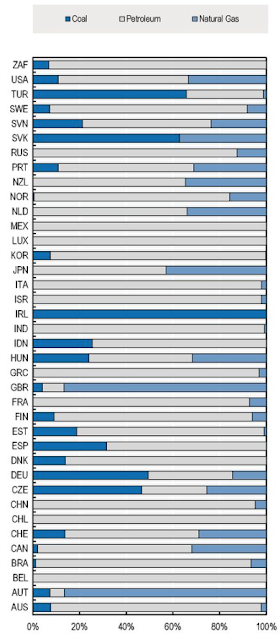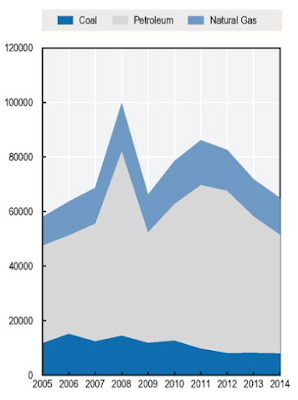This article was last updated on April 16, 2022
Canada: ![]() Oye! Times readers Get FREE $30 to spend on Amazon, Walmart…
Oye! Times readers Get FREE $30 to spend on Amazon, Walmart…
USA: ![]() Oye! Times readers Get FREE $30 to spend on Amazon, Walmart…
Oye! Times readers Get FREE $30 to spend on Amazon, Walmart…
An interesting report from the OECD looks at how much governments (i.e. taxpayers) subsidize both fossil fuel consumption and production in both developed and developing economies. The data used in the study are obtained from government sources and cover the years between 2010 and 2014. Here are some of the highlights of the report.
Let's start with this figure which shows International Energy Agency estimates of fossil fuel subsidies by fuel type by year:
The IEA estimates that 40 nations subsidize their consumption of fossil fuels which accounts for over half of the world's energy consumption. Of the forty nations, ten countries account for almost 75 percent of total consumer subsidies and five of these nations are oil and gas exporters located in the Middle East or North Africa. In total, the IEA estimates that fossil fuel subsidies in 2013 totalled US$548 billion.
The database organized by the OECD covers 40 nations; 34 OECD member nations and six other partner economies including Brazil, China, India, Indonesia, Russia and South Africa. A total of 40 fuel types are covered including primary fossil fuel commodities like crude oil, natural gas, coal and peat. Primary fuels also include those that are extracted from bituminous sands, natural gas sourced from shale and coal bed methane. Other fuels include processed fossil fuel products such as diesel, gasoline and kerosene. As I noted above, the data has generally been obtained from government sources and if no data was found, the OECD estimated the value of the subsidies.
Here is a figure showing the composition of total support for each fuel type by each nation in the study:
Here is a figure that shows the total subsidies for fossil fuels in OECD nations between 2004 and 2014:
Here is a figure that shows the total subsidies for fossil fuels in the selected partner economies between 2005 and 2014 as noted above:
As we can see, most of the subsidies in both groups of nations are applied to petroleum. Between the two groups of nations, overall subsidies for fossil fuels remains high at US$160 billion in 2014 although in both groups, the level of subsidies have dropped from the US$200 billion level earlier in the new millennium in 2008 and 2011 – 2012. Here is a summary of the decrease in subsidies by each group of nations:
1.) OECD Nations: Mexico is responsible for a significant portion of the decrease in support for fossil fuels among OECD nations because it eliminated subsidies for the consumption of gasoline and diesel fuel through its floating excise tax. The Mexican government has steadily increased the retail price of gasoline and diesel to reduce the level of government support to consumers. In 2012, total consumer support was US$18.5 billion and by 2014, support had dropped to US$2.5 billion. The Netherlands has passed out an excise tax reduction that it had been applying to diesel fuel used for farming and heating activities. Germany has reduced the budgetary transfers that it had applied to hard-coal mines in the North Rhine-Westphalia region. France has gradually removed the exemption from excise tax that it applied to natural gas consumed by households.
2.) Partner Economies: Most of the decline in fossil fuel subsidies among partner nations is related to India's drop in spending on consumer subsidies for diesel fuel. Between 2012 and 2014, the Indian government has periodically raised the retail price of diesel by small increments; this has dropped subsidies from US$18 billion in 2012 to US$10 billion in 2014. Subsidies still exist for kerosene and LPG. Indonesia has also scrapped all of its subsidies for gasoline in the first quarter of 2015 and has capped the subsidies that it provides for diesel. These measures are expected to reduce Indonesia's fossil fuel subsidies by US$10 billion in a single year.
Let's switch gears for a moment. Here is a figure which compares the emissions of carbon dioxide from both fossil fuels and forestry and other land use since 1980 in gigatonnes (billions of tonnes) per year:
If the governments of the world intend to get serious about reducing carbon dioxide emissions, one would think that the provision of subsidies for the consumption of fossil fuels and their derivatives is working against that goal. Regardless, from this study, we can see that the subsidies provided for fossil fuels by some of the world's most influential economies are substantial and that these subsidies distort the economics (i.e. rate of return) of some of the world's largest energy projects. As well, in many cases, it is our tax dollars that are supporting the energy business.
Click HERE to read more of Glen Asher's columns
You can publish this article on your website as long as you provide a link back to this page.






Be the first to comment